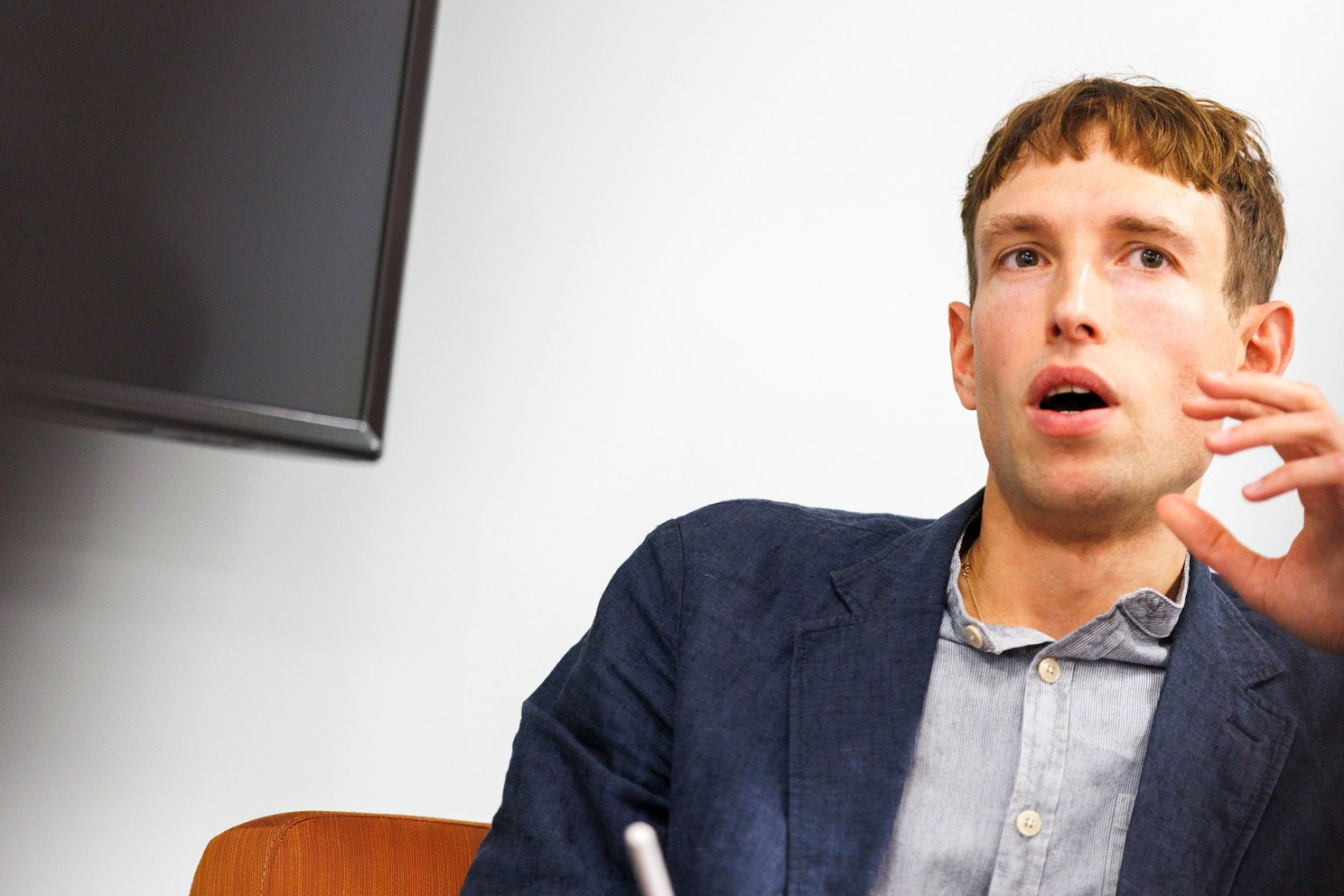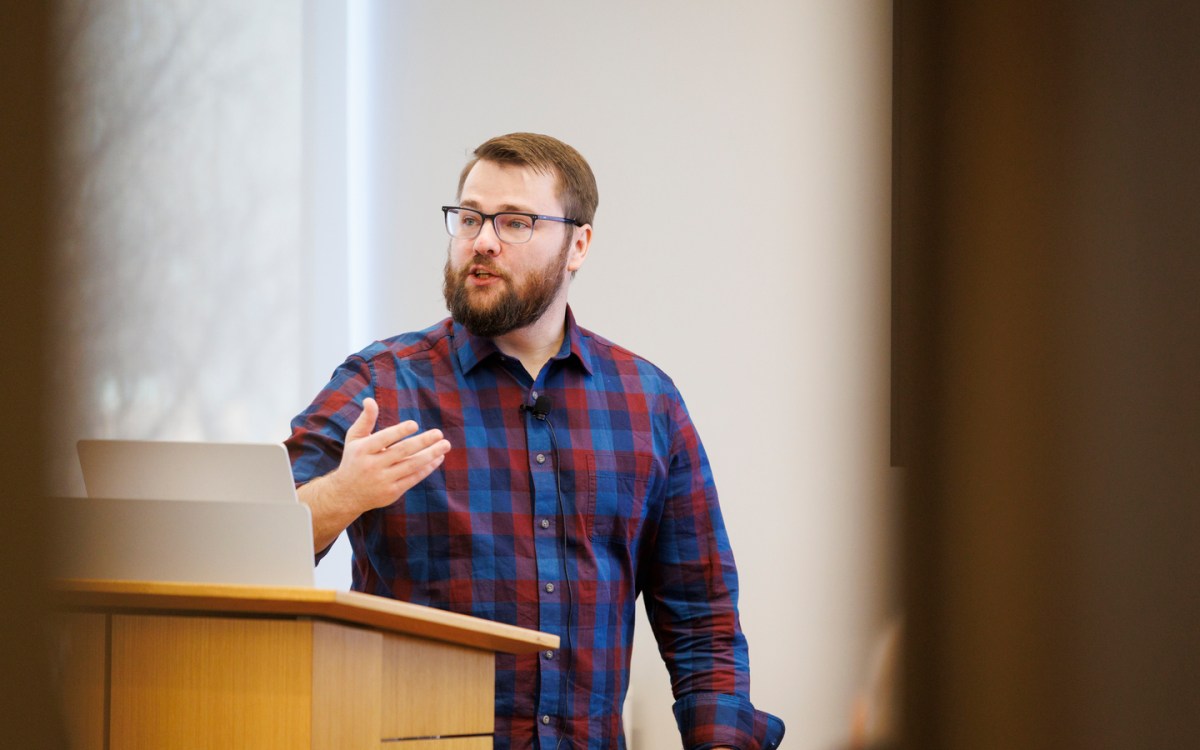
Daniel Chandler.
Stephanie Mitchell/Harvard Staff Photographer
U.S. seems impossibly riven. What if we could start from scratch?
Key would be focusing on social, political, economic fairness, according to new book on ideas of political philosopher John Rawls
A new book by Daniel Chandler, “Free and Equal: A Manifesto for a Just Society,” offers a vision for democratic change inspired by the work of John Rawls, the towering political philosopher who joined the Harvard faculty in 1962 and maintained ties to the University until his death in 2002. Rawls’ 1971 magnum opus, “A Theory of Justice,” has influenced generations of philosophers and legal scholars.
In a conversation that has been edited for clarity and length, Chandler, an economist and philosopher at the London School of Economics who studied at Harvard under Nobel Prize-winning economist Amartya Sen, explained why Rawls’ ideas speak to the present day. This interview has been edited for clarity and length.
Which of Rawls’ principles offer the best framework for envisioning change?
The fundamental idea of Rawls’ philosophy is that society should be fair, and he developed a famous thought experiment called the “original position” for thinking about what that might actually mean. If we want to know what a fair society would look like, we should imagine how we would choose to organize it if we didn’t know what our position in that society would be, whether we would be rich or poor, gay or straight, Black or white, as behind what he called a “veil of ignorance.” It’s a very intuitive way to think about fairness, similar to the idea that someone might cut a cake more fairly if they didn’t know which piece they were going to end up getting.
“It’s a very intuitive way to think about fairness, similar to the idea that someone might cut a cake more fairly if they didn’t know which piece they were going to end up getting.”
He uses this thought experiment to identify two fundamental principles, to do with freedom and equality respectively — hence the title of my book — that we can then use to think about how to design the basic institutions of a democratic society: what the Constitution should look like, how to organize the political process, the broad outlines of our economic system, including the role of markets, the nature of property rights, the scope of government intervention, and so on.
Rawls’ first principle is what he called the “basic liberties” principle. That’s the idea that everyone is entitled to a set of truly fundamental freedoms, including both personal freedoms, such as freedom of speech, religion, sexuality, but also political freedoms — not just the right to vote, but all of the freedoms that we need to play a part as genuine equals in the political process.
His second principle has two parts. The first is what he called “fair equality of opportunity.” That’s not just the absence of discrimination but the idea that everyone should have a genuinely equal chance to develop and apply their talents and abilities in life. Equality of opportunity is sometimes seen as the less radical partner to equality of outcome, but it’s really a very demanding ideal, one that countries like America and the U.K. fall far short of today.
The second is the “difference principle” — the idea that we should organize our economy so that the least well-off are better off than they would be under any alternative economic system. So, some inequality can be justified because it’s necessary for markets to function well, and higher pay gives people incentives to work hard and innovate, but we need to make sure the benefits are widely shared, and that isn’t something we can just leave to markets.
One of the things that I think is most interesting and important about Rawls’ economic thinking, but has often been overlooked, is that when he’s talking about inequality and economic justice, he’s not only talking about the distribution of financial resources. He’s concerned with how our society distributes power and control, like the balance of power between owners and workers, and also what he calls the “social bases of self-respect,” which include having a sense of independence, of being able to stand on your own two feet, social recognition from our peers, and opportunities for meaningful work.
Historically, one critique of Rawls is that his ideas, while important, are not very pragmatic and don’t offer a roadmap for change. How might the kind of change you propose come to fruition?
I think that’s a fair criticism. You know, although Rawls is really the unrivaled giant of 20th-century political philosophy, his ideas haven’t had much impact on popular debate or public policy, at least not compared to Milton Friedman and F.A. Hayek. I think it’s this lack of practical application that helps explain this gap. I’ve tried to pick up where Rawls left off and flesh out how we could put his ideas into practice.
In terms of how change can happen, there aren’t easy answers. But we can be pretty certain that change won’t happen unless political parties and the people who shape our public debate are able to articulate a positive and unifying vision of where they want society. The starting point for making the quite deep changes that America needs, to both its political and economic institutions, is to be able to articulate that positive vision.
Some commentators have suggested a binary choice — liberal principles on one side, authoritarian ideas on the other — in the coming presidential election. You say we should reject that idea.
It’s not that I don’t think that choice exists; it’s that I think it’s possible and necessary to try to appeal to people across the spectrum. What I’m rejecting is the idea that society is divided into two fixed camps who can’t speak to one another anymore. It’s still the case that large majorities support liberal freedoms, the existence of a democratic political system, and an economy that is broadly market-based, but genuinely works for everybody. The divide is much more tied to party identification rather than to issues. So, despite how divided things seem right now, I think it’s possible to build a broad-based coalition around these kinds of ideas, and I hope my book provides people with the ideas and arguments to try to do that.
Related story
-
 Nation & World
Nation & WorldCan a 50-year-old philosophy help make democracy better today?
New book based on ideas of renowned Harvard scholar John Rawls argues it all comes down to fairness




